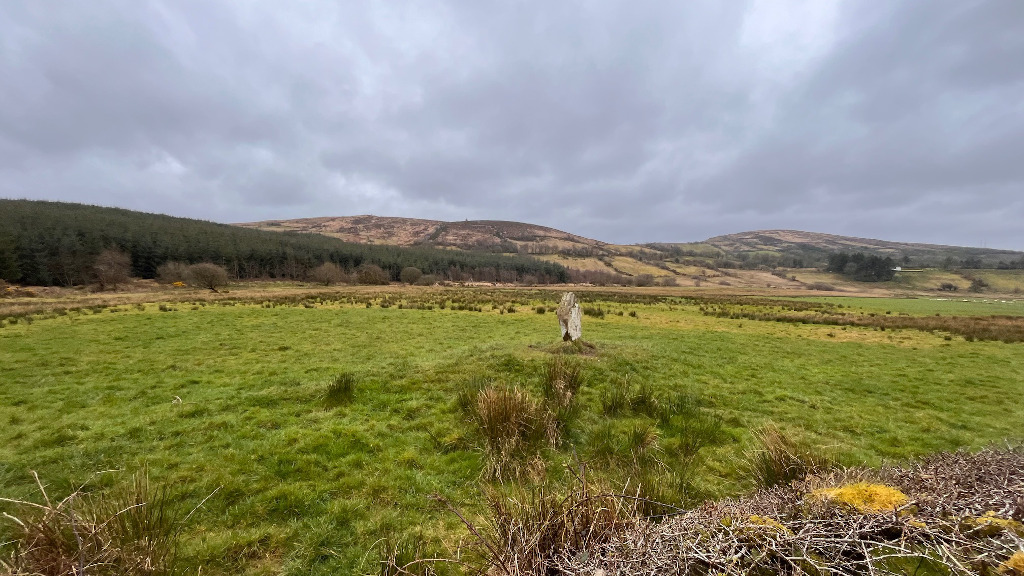
Twin cairns in Ballyhubbock Upper townland, part of the Spinans Hill cairn cemetery.

Twin cairns in Ballyhubbock Upper townland, part of the Spinans Hill cairn cemetery.


Kerbstones visible on the northern side of of one of the cairns.

The most northerly of the six cairns looking north.


Centre firepit with 3-armed Brigid’s cross and quartz offerings.


They left a substantial margin between the trees and the circle this time, allowing a bit of breathing space but encroaching on the views. Keadeen doesn’t mind either way.

Brusselstown ring with Keadeen behind, from just below the summit of Spinans Hill.


From ‘Volpaire’ on Google Maps
Dan Clancy was a local man who grew up on Slievecorragh and often walked its slopes with his family.
Dan and his many siblings spent many happy childhood days there, and often went up in the evening to watch the sun set.
Clancy later emigrated to New York, where he was diagnosed with terminal cancer. He passed away in 2004 at the young age of 31.
Following his death, his brother Andrew – a sculptor – created the chair as a memorial to Dan. Andrew Clancy, is said to have based it on one in the family kitchen.
There are many teddy bears left on the chair by hikers and those wishing to commemorate him. The ring on the chair and the original teddy bear were donated by Clancy’s partner in New York.

The flagpole marks the highest point of Kilknock – the tomb, as is so often the case, is not sited on the summit, but 5 metres below it and 100 metres to the west.

Brougher mountain, to the left of the hill with the aerials, has 2 stone alignments, a possible megalithic tomb, a standing stone and 2 stone circles.

The turf, with the aid of plenty of sphagnum, has grown to almost inundate the stones of the chamber.

The stone in the foreground could be part of chamber outer walling or possibly a kerbstone.


Aligned NE-SW, the modern wall, probably using stone from the covering cairn, crosses the front of the chamber.


A metre tall, a metre and a half wide.





Two orthostats from the main tomb. Another couple of months and nothing will be visible.

Marked as ‘standing stones’ on the OS map, this arrangement is possibly the wall of a chamber of a second tomb. The main, overgrown tomb is under the gorse at the top of the hill.


There may be two chambers in the gallery of the tomb, but it was hard to figure out.




The front of the tomb is to the right – it’s mostly wrecked.

Which came first? Well, the tree actually – the stone is one of a pair, bulldozed and buried in a ditch; then this one was dug up and re-erected here by the farmer, not its original position.


Quite a substantial stone, but not in its original position, and without its partner.



Towards the south-east corner of an old graveyard and church.


The ground rises to the left in the distance towards the summit of Sliabh Beagh.



Small circle stone on the west arc of the main mound.

Ancient human remains which date back more than 2,000 years have been recovered by the Police Service of Northern Ireland (PSNI).
The discovery was made after archaeologists were alerted to human bones on Bellaghy peatland in County Londonderry in October 2023.
It is thought the remains could be those of a teenage boy.
The PSNI said it is a “unique archaeological discovery for Northern Ireland”.
It explained that the remains had been carbon dated to “as old as 2,000-2,500 years”.
Det Insp Nikki Deehan said excavations “first uncovered a tibia and fibula and a humerus, ulna, and radius bone relating to the lower left leg and right arm respectively”.
“Further investigation revealed more bones belonging to the same individual,” she added.

Low winter sun over the Mound of the Hostages.
Archaeologists have uncovered evidence of a cave dwelling that was constructed around 16,800 years ago by prehistoric humans.
The dwelling was found in the La Garma cave complex in the autonomous community of Cantabria, northern Spain, the local government announced in a statement.
The new discovery is “one of the best preserved Paleolithic dwellings” in the world, according to the Government of Cantabria. The Paleolithic, also referred to as the Old Stone Age, is a period in human prehistory that extends from the earliest use of stone tools more than 3 million years ago to around 12,000 years ago.
Continues: newsweek.com/archaeologists-find-16800-year-old-cave-dwelling-one-best-1850021
Damage done to an ancient Neolithic passage tomb in Co Sligo has been strongly condemned.
Photographer Ken Williams visited the site over the weekend and took photographs of words and shapes scratched into stones at the tomb which is over 5,000 years old.
More: rte.ie/news/regional/2023/1016/1411157-carrowkeel-graffiti/

I was surprised by the extent of the informative board, even if some of the info is a tad skewed.
